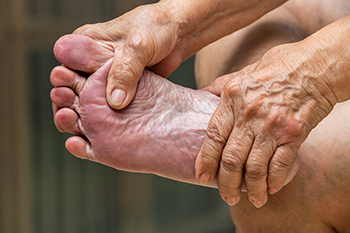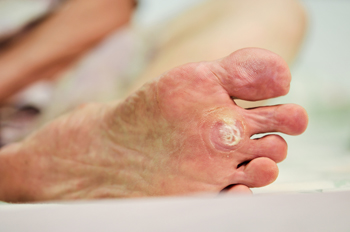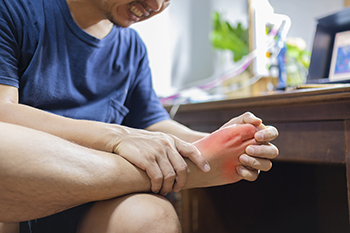Items filtered by date: August 2022
Treating Plantar Fasciitis With Surgery

Plantar fasciitis is one of the most common foot conditions that causes heel pain. The plantar fascia is a long band composed of tissue, running from the heel to the toes. The plantar fascia also makes up the arch of the foot. When this band of tissue becomes irritated or inflamed, it is known as plantar fasciitis. This condition can be treated in several ways. If you do not respond to any of the less severe treatment options like orthotics or anti-inflammatory medications, you might be a candidate for a surgical procedure. The surgery, known as plantar fasciotomy, is a procedure that essentially moves the affected fascia away from the heel bone. This is done to ultimately reduce the tension that is causing the condition. There are two main kinds of surgery for plantar fasciitis. First, you may have an open surgery, which is performed in a hospital and includes making a 1-2 inch incision. Alternatively, you may have an endoscopic surgery, which involves making two small incisions that are less than half an inch deep. There are a variety of factors that can determine whether you are a candidate for this kind of surgery. If you are interested in this treatment and want to learn more, contact a podiatrist.
Plantar fasciitis can be very painful and inconvenient. If you are experiencing heel pain or symptoms of plantar fasciitis, contact one of our podiatrists from Centers for Foot & Ankle Care. Our doctors can provide the care you need to keep you pain-free and on your feet.
What Is Plantar Fasciitis?
Plantar fasciitis is the inflammation of the thick band of tissue that runs along the bottom of your foot, known as the plantar fascia, and causes mild to severe heel pain.
What Causes Plantar Fasciitis?
- Excessive running
- Non-supportive shoes
- Overpronation
- Repeated stretching and tearing of the plantar fascia
How Can It Be Treated?
- Conservative measures – anti-inflammatories, ice packs, stretching exercises, physical therapy, orthotic devices
- Shockwave therapy – sound waves are sent to the affected area to facilitate healing and are usually used for chronic cases of plantar fasciitis
- Surgery – usually only used as a last resort when all else fails. The plantar fascia can be surgically detached from the heel
While very treatable, plantar fasciitis is definitely not something that should be ignored. Especially in severe cases, speaking to your doctor right away is highly recommended to avoid complications and severe heel pain. Your podiatrist can work with you to provide the appropriate treatment options tailored to your condition.
If you have any questions please feel free to contact one of our offices located in Merrillville, Portage, Michigan City/LaPorte, and Schererville, IN . We offer the newest diagnostic and treatment technologies for all your foot and ankle needs.
Lumps on the Side of the Foot

Finding a lump on the side of your foot can be disturbing. Common causes of lumps include injuries, ganglion cysts, bursitis, and plantar fibromas. An injury to the foot may result in the formation of a lump, along with swelling and bruising. These symptoms will normally subside once the injury heals. Ganglion cysts are benign growths with a jelly-like consistency. They normally do not cause pain unless they rub against a shoe or hit a nerve. They can be drained by a podiatrist. Bursitis is the inflammation of a fluid sac, called a bursa. It may be the result of overuse or repetitive stress. Bursitis can be quite painful. Plantar fibromas usually form on the arch of the foot, but sometimes are found on the side. Also benign, these growths have a more solid texture than ganglion cysts. The cause is not known, but they can be removed. While any of these lumps are generally non threatening, it is suggested that any growth that develops on the side of the foot be checked out by a podiatrist who can examine it and offer treatment options.
Everyday foot care is very important to prevent infection and other foot ailments. If you need your feet checked, contact one of our podiatrists from Centers for Foot & Ankle Care. Our doctors can provide the care you need to keep you pain-free and on your feet.
Everyday Foot Care
Often, people take care of their bodies, face and hair more so than they do for their feet. But the feet are a very important aspect of our bodies, and one that we should pay more attention to. Without our feet, we would not be able to perform most daily tasks.
It is best to check your feet regularly to make sure there are no new bruises or cuts that you may not have noticed before. For dry feet, moisturizer can easily be a remedy and can be applied as often as necessary to the affected areas. Wearing shoes that fit well can also help you maintain good foot health, as well as making it easier to walk and do daily activities without the stress or pain of ill-fitting shoes, high heels, or even flip flops. Wearing clean socks with closed shoes is important to ensure that sweat and bacteria do not accumulate within the shoe. Clean socks help to prevent Athlete’s foot, fungi problems, bad odors, and can absorb sweat.
If you have any questions please feel free to contact one of our offices located in Merrillville, Portage, Michigan City/LaPorte, and Schererville, IN . We offer the newest diagnostic and treatment technologies for all your foot and ankle needs.
Elderly Foot Care Is Simple To Maintain

It is recommended that proper foot care is maintained as a daily habit. It is important to practice everyday foot care during the aging process, as this can help in mobility and range of motion. This is needed to enjoy walking, shopping, and generally being active. Wearing comfortable shoes is important to the overall health of the body, and it can be beneficial to alternate the shoes that are worn with a second pair. Additionally, it can help to refrain from walking barefoot, as this can prevent athlete’s foot and blisters. The shoes that are worn can help to improve balance, and decrease the risk of falling. A good time to purchase shoes is at the end of the day when the feet are at their largest, and they should feel comfortable from the moment they are tried on. Some patients wear custom made orthotics with existing medical conditions that can consist of arthritis and chronic foot ailments. Trimming the toenails correctly can possibly prevent an ingrown toenail from developing, and corns may be prevented by weaning shoes that have adequate room for the toes to move freely in. If you would like more information about the importance of maintaining elderly foot care, please consult with a podiatrist.
Proper foot care is something many older adults forget to consider. If you have any concerns about your feet and ankles, contact one of our podiatrists from Centers for Foot & Ankle Care. Our doctors can provide the care you need to keep you pain-free and on your feet.
The Elderly and Their Feet
As we age we start to notice many changes in our body, but the elder population may not notice them right away. Medical conditions may prevent the elderly to take notice of their foot health right away. Poor vision is a lead contributor to not taking action for the elderly.
Common Conditions
- Neuropathy – can reduce feeling in the feet and can hide many life-threatening medical conditions.
- Reduced flexibility – prevents the ability of proper toenail trimming, and foot cleaning. If left untreated, it may lead to further medical issues.
- Foot sores – amongst the older population can be serious before they are discovered. Some of the problematic conditions they may face are:
- Gouging toenails affecting nearby toe
- Shoes that don’t fit properly
- Pressure sores
- Loss of circulation in legs & feet
- Edema & swelling of feet and ankles
Susceptible Infections
Diabetes and poor circulation can cause general loss of sensitivity over the years, turning a simple cut into a serious issue.
If you have any questions please feel free to contact one of our offices located in Merrillville, Portage, Michigan City/LaPorte, and Schererville, IN . We offer the newest diagnostic and treatment technologies for all your foot and ankle needs.
Are You Suffering From Ingrown Toenails?
When Plantar Warts Are Painful

Plantar warts are small patches of hardened growths that can form on the bottom, or sole, of someone’s feet. These warts are spread from one person to another through the human papillomavirus (HPV). Importantly, plantar warts are significantly different from corns, which form on the top of toes in response to friction or stress. Many cases of plantar warts may not cause the patient any pain. However, there are instances in which warts might be painful. If you have a larger plantar wart that essentially splits open, this could be a sign that pain might be felt later. This is because the tissue underneath a larger plantar wart can become irritated, which might ultimately result in bleeding and pain. Additionally, plantar warts can also cause the patient pain depending on where they are located. Warts that are situated on the skin folds of the toes can be especially painful. If a wart is growing inward, typically in response to the body putting pressure on the bottoms of feet when standing, then this can also be particularly painful. Contact a podiatrist for help with your plantar warts.
Plantar warts can be very uncomfortable. If you need your feet checked, contact one of our podiatrists from Centers for Foot & Ankle Care. Our doctors will assist you with all of your foot and ankle needs.
About Plantar Warts
Plantar warts are the result of HPV, or human papillomavirus, getting into open wounds on the feet. They are mostly found on the heels or balls of the feet.
While plantar warts are generally harmless, those experiencing excessive pain or those suffering from diabetes or a compromised immune system require immediate medical care. Plantar warts are easily diagnosed, usually through scraping off a bit of rough skin or by getting a biopsy.
Symptoms
- Lesions on the bottom of your feet, usually rough and grainy
- Hard or thick callused spots
- Wart seeds, which are small clotted blood vessels that look like little black spots
- Pain, discomfort, or tenderness of your feet when walking or standing
Treatment
- Freezing
- Electric tool removal
- Laser Treatment
- Topical Creams (prescription only)
- Over-the-counter medications
To help prevent developing plantar warts, avoid walking barefoot over abrasive surfaces that can cause cuts or wounds for HPV to get into. Avoiding direct contact with other warts, as well as not picking or rubbing existing warts, can help prevent the further spread of plantar warts. However, if you think you have developed plantar warts, speak to your podiatrist. He or she can diagnose the warts on your feet and recommend the appropriate treatment options.
If you have any questions please feel free to contact one of our offices located in Merrillville, Portage, Michigan City/LaPorte, and Schererville, IN . We offer the newest diagnostic and treatment technologies for all your foot and ankle needs.
What Is Gout and How Can It Be Prevented?

A common condition that affects the feet is known as gout. It falls into the arthritis category, and can cause severe pain and discomfort. It develops as a result of elevated uric acid levels in the blood, and this can cause crystals to form in the joints of the big toe, as well as other joints. Causes are varied, including being overweight, eating excessive red meat and shellfish, and consuming drinks that are made with large amounts of sugar. Additionally, existing medical conditions, such as congestive heart failure, diabetes, and poor kidney function may lead to developing gout. The symptoms that are often associated with this condition may include swelling, intense pain, redness, and the affected area may feel hot when touched. Gout is often diagnosed during a flare up, and a needle may be inserted into the affected joint that can provide a sample of the crystals. Effective prevention strategies of gout can consist of eating a healthy diet, getting and staying physically active, and managing weight. If you have gout attacks, it is suggested that you speak with a podiatrist who can provide you with correct treatment and preventive techniques.
Gout is a foot condition that requires certain treatment and care. If you are seeking treatment, contact one of our podiatrists from Centers for Foot & Ankle Care. Our doctors will treat your foot and ankle needs.
What Is Gout?
Gout is a type of arthritis caused by a buildup of uric acid in the bloodstream. It often develops in the foot, especially the big toe area, although it can manifest in other parts of the body as well. Gout can make walking and standing very painful and is especially common in diabetics and the obese.
People typically get gout because of a poor diet. Genetic predisposition is also a factor. The children of parents who have had gout frequently have a chance of developing it themselves.
Gout can easily be identified by redness and inflammation of the big toe and the surrounding areas of the foot. Other symptoms include extreme fatigue, joint pain, and running high fevers. Sometimes corticosteroid drugs can be prescribed to treat gout, but the best way to combat this disease is to get more exercise and eat a better diet.
If you have any questions please feel free to contact one of our offices located in Merrillville, Portage, Michigan City/LaPorte, and Schererville, IN . We offer the newest diagnostic and treatment technologies for all your foot and ankle needs.

